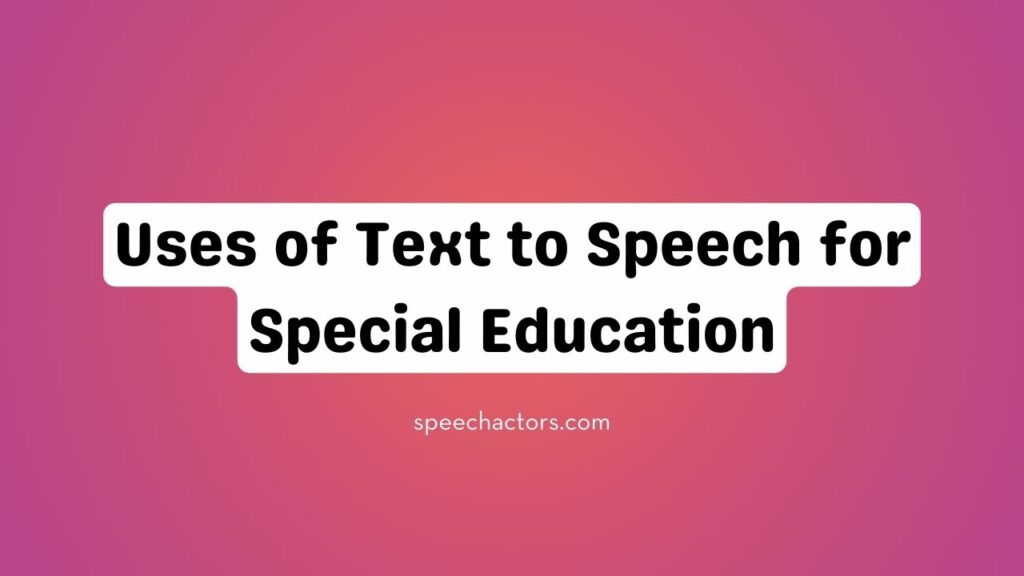Text-to-Speech (TTS) technology converts written text into natural-sounding speech, creating a powerful tool for learning. In special education, accessibility and inclusive learning are essential for supporting students with diverse abilities.
TTS enhances engagement, comprehension, and independence by allowing learners to listen to lessons, instructions, and study materials in their own pace.
By bridging gaps in reading or processing, TTS empowers students with learning differences, visual impairments, or language challenges to participate fully in the classroom. Its integration fosters confidence, focus, and a more personalized educational experience for every learner.
How TTS Supports Special Education
Text-to-Speech (TTS) technology reads written text aloud, turning books, documents, and digital content into clear spoken words. It helps students focus, understand, and retain information easily.
Students with learning disabilities, dyslexia, or visual impairments benefit greatly as TTS makes reading faster and less tiring, improving comprehension and confidence. English as a Second Language (ESL) learners gain better pronunciation and vocabulary, while students with speech difficulties can follow along and participate more fully in lessons.
TTS creates an inclusive learning environment, allowing every student to engage with content at their own pace and feel supported in their unique learning journey.
Key Uses of TTS in Special Education
- Reading Assistance: Helping students with reading challenges
- Writing Support: Aiding in spelling, grammar, and sentence construction
- Language Development: Improving pronunciation, vocabulary, and comprehension
- Classroom Inclusion: Providing equal access to digital content
- Homework and Study Support: Enabling independent learning at home
Strategies for Educators to Integrate TTS Effectively
Educators can enhance learning by selecting high-quality TTS software like Speechactors, which delivers natural, clear, and expressive voices.
Personalizing voices and adjusting playback speed helps match students’ learning styles, making lessons easier to follow and understand. Combining TTS with other assistive technologies, such as screen readers or visual aids, creates a richer, more engaging learning experience.
Monitoring student progress and collecting feedback ensures that TTS use continually supports learning goals. Regularly observing how students interact with TTS content helps educators refine their approach, making lessons more interactive, inclusive, and enjoyable for every learner.
Success Stories: TTS in Special Education
Text-to-Speech (TTS) has transformed learning for students with special needs. Case studies show that children using TTS tools improved reading speed, comprehension, and writing accuracy.
In one classroom, students who struggled with dyslexia became more confident in reading aloud, completing tasks faster, and expressing their ideas clearly. Educators noticed higher engagement as students actively participated in lessons and enjoyed interactive exercises.
A teacher shared, “TTS makes learning fun and accessible for every child.” Students also expressed excitement, saying, “I can read and understand better now!” These success stories highlight how TTS creates a supportive, inclusive, and motivating environment for learners.
Challenges and Solutions in Using TTS for Special Education
Using Text-to-Speech (TTS) in special education brings exciting opportunities and unique challenges. Managing technical issues and software compatibility is key, as different devices and platforms must work smoothly together for seamless learning.
Avoiding over-reliance on audio support ensures students develop reading and comprehension skills alongside listening. Ensuring accessibility compliance makes TTS tools usable for all students, including those with visual or learning difficulties, while keeping them engaged with interactive features like adjustable voices and speeds.
Studies show that combining TTS with visual cues and interactive content helps students stay focused, understand lessons better, and feel confident while learning in a supportive environment.
Why Choose Speechactors for Special Education

Speechactors offers high-quality, natural-sounding voices that make learning engaging and clear for every student. Its unique features include expressive tones and lifelike speech, which help learners connect with the content easily.
The platform allows full customization, letting educators adjust speed, pitch, and style to match diverse learning needs, including students with learning differences or attention challenges. Studies show that using clear, adaptive voiceovers can improve focus, comprehension, and retention for special education learners.
Educators report that Speechactors makes lessons more interactive and inclusive, supporting better understanding and participation. With proven results, it transforms teaching methods while creating a welcoming and effective learning environment for all
Frequently Asked Questions (FAQs)
How does TTS help students with dyslexia?
TTS reads text aloud clearly, helping students with dyslexia understand words faster, improve focus, and reduce reading stress. Studies show it boosts comprehension and learning confidence.
Can TTS improve reading and writing skills?
TTS supports reading fluency and spelling by letting students hear words as they read, reinforcing correct pronunciation and sentence structure, which enhances overall writing and reading skills.
Is TTS compatible with all educational platforms?
Most TTS tools, including Speechactors, work on web apps, mobile devices, and popular e-learning platforms, making learning accessible anytime and anywhere for students.
What voices and languages are available in Speechactors?
Speechactors offers natural-sounding voices in multiple languages, accents, and tones. Students can select voices that match their learning style and preference for better understanding.
How can TTS be personalized for individual student needs?
TTS lets students adjust speed, voice type, and reading style. Personalization improves engagement, comprehension, and makes learning enjoyable according to each student’s pace.
Conclusion
Text-to-speech technology is transforming special education by making learning more accessible, engaging, and personalized for every student. From supporting reading comprehension to boosting confidence and independence, TTS empowers learners with diverse needs to thrive in the classroom.
Educators who embrace this technology can create inclusive, dynamic learning environments that truly cater to all abilities. Explore Speechactors today to integrate high-quality TTS solutions into your teaching and unlock a world where every student can learn, participate, and succeed.
